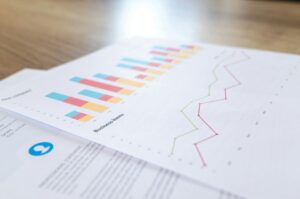- Understand how you use research in writing business reports
- Understand the steps in the research process
- Identify the main types of data used in business reports
- Understand the difference between primary and secondary research
Using Data in Reports

Business communication, done well, requires thoughtful planning and carefully crafted media. Research is a key component of building good communication. Whatever form your communication takes, doing research will enhance your communication and your credibility in the workplace.
A business report is any formal or informal document or set of documents used to analyze a business situation and help decision-makers aid the business. Reports use data in various forms to support conclusions and/or inform their audience.
There are two types of business reports and both use a variety of data:
- Analytical Reports: those used to help make a decision (e.g., whether to hire more people, expand a product line, etc.)
- Informational Reports: those used to inform people throughout the organization about something of importance.
All reports should be true, factual, and helpful. An analytical report should help decision-makers with a very specific type of decision or action. Usually, decision-makers will ask themselves, “Do I have everything I need to make a sound and well-informed decision?” Any reports for decisions or actions should be designed around answering this question. Additionally, analytical reports should make a recommended solution, based on the data provided in the report.
Informational reports are usually shorter and simply disseminate information about organizational happenings. People are generally familiar with memos, newsletters, or other similar items. Informational reports are similar to these items in that they relay something of importance to the organization. Think of an informational report as being more concise and presenting more data than a memo or newsletter.
Characteristics of Reports
Business reports should be:
- true and factual
- concise
- designed to help others make decisions
- free from unnecessary or extra information
- simple; they should address one question (i.e., well-scoped)
Often employees in a given organization who are tasked to assemble business reports will create something too broad or too detailed. This may happen with more junior or less-experienced individuals who wish to demonstrate their skills. Ironically, in report writing and business communication in general, less is more.
The writer of any report is encouraged to think like an executive:
- What do I need to know right away?
- How quickly do I need to make a decision?
Interestingly, perfect information is not always available or even needed. Speed, especially around decision-making, is also key. Jeff Bezos, CEO of Amazon said:[1]
Most decisions should probably be made with somewhere around 70 percent of the information you wish you had. If you wait for 90 percent, in most cases, you’re probably being slow. Plus, either way, you need to be good at quickly recognizing and correcting bad decisions. If you’re good at course correcting, being wrong may be less costly than you think, whereas being slow is going to be expensive for sure.
Vast amounts of data are available through research and it can be hard to determine what data is useful. If we define data as, “plain facts, usually numbers,” as Elon University does[2], that means we need first to understand the type of data we need, then we have to understand its source(s), and lastly, we have to make sense of the data for our purposes. This requires us to view report writing as essentially a research project. As student researchers yourselves, you will develop skills that utilize a research mindset which will transform you into informed decision-makers.